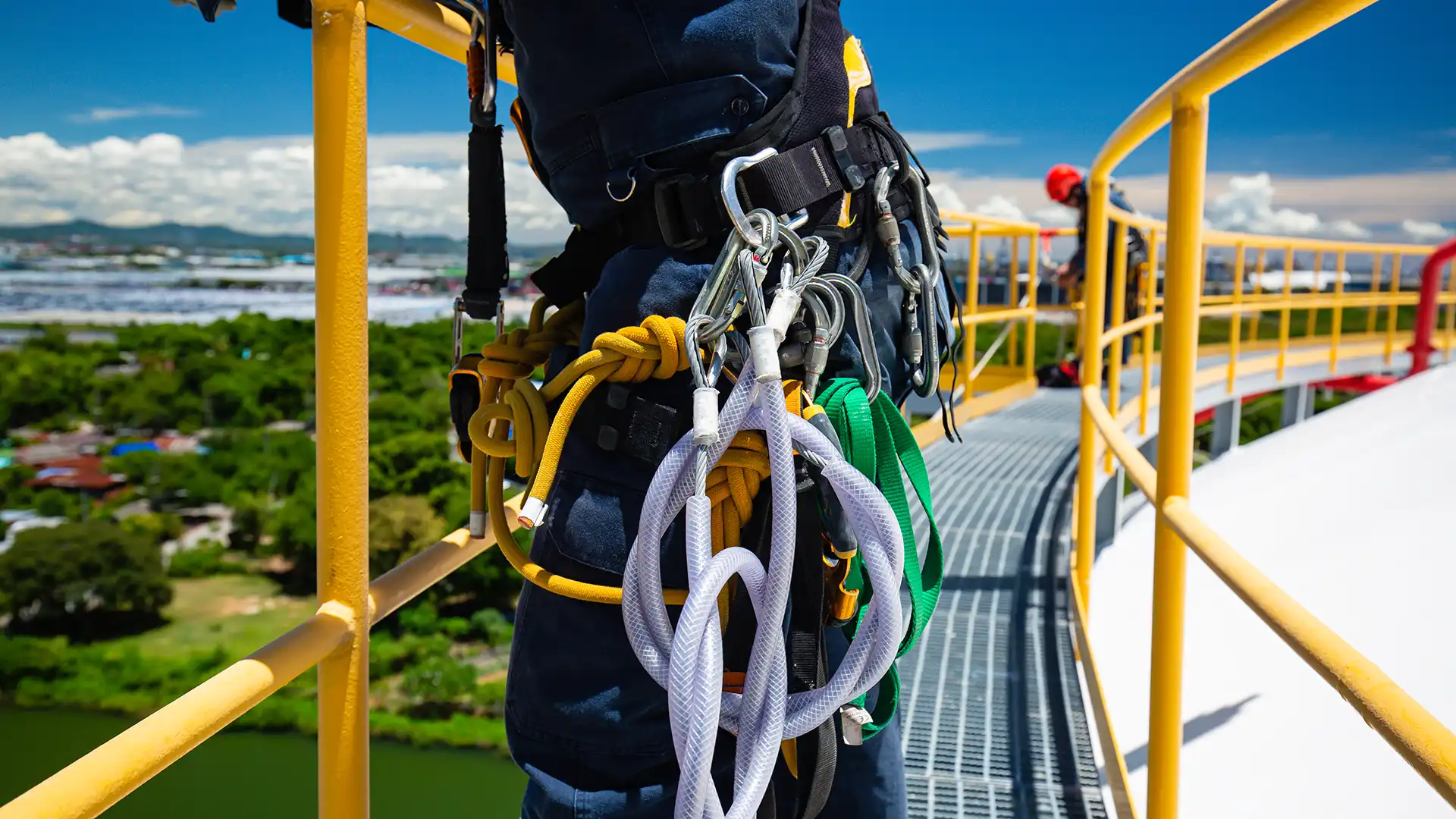A lanyard is a fundamental component of personal protective equipment used to mitigate the risk of falls when working at heights. These systems ensure safe working conditions not only when used correctly but also when regularly inspected and maintained. Considering that many accidents stem from neglected equipment maintenance, it is clear that proper lanyard maintenance and timely replacement are vital issues.
The Importance of Lanyard Maintenance
Lanyard maintenance not only extends the lifespan of the equipment but also ensures the safety of workers. Without regular maintenance, the lanyard’s material may weaken, connection points may wear out, and it may fail to perform as expected during a fall. Therefore, lanyard maintenance should not be neglected and must be regarded as a routine process.
Key points to consider:
- Visual inspection: Before each use, check the rope for cuts, wear, or loose stitching.
- Energy absorber check: For models with energy absorbers, ensure the integrity of the absorber section if it is within a transparent cover.
- Carabiners and connectors: The locking mechanism should close smoothly, and signs of rust or deformation should be monitored.
- Cleaning: Remove dirt, oil, or chemical residues with a damp cloth, avoiding abrasive cleaners.
- Proper storage: Store in a clean, airy environment away from sunlight, high temperatures, humidity, or chemicals.
When Should a Lanyard Be Replaced?
The replacement of a lanyard should not be based on a fixed schedule but rather on the condition of the equipment and its usage environment. EKS Work Safety recommends replacing the lanyard in the following situations:
- Visible damage: If there are signs of wear, cuts, holes, or discoloration in the fibers.
- Stiffness or looseness: If the lanyard’s texture has become stiff or loose, this may indicate material weakness.
- Issues with connectors: If there is rust, deformation, or malfunction in the locking mechanism of carabiners or hooks.
- After a fall: If the lanyard has been used in a fall, it should be replaced immediately, even if no visible damage is present. The forces exerted during a fall can cause internal damage that is not visible.
- Manufacturer recommendations: Generally, lanyards should be replaced after 2-3 years of use, depending on the frequency and conditions of use. However, for those working in harsh conditions, this period may be shorter.
What to Consider When Replacing a Lanyard
- Compliance with standards: When selecting a new lanyard, ensure it meets international safety standards.
- Choosing the right type: Select a lanyard type suitable for the working environment. For example, energy-absorbing lanyards are preferred in areas with a high risk of falls.
- Training: Workers should be trained on the correct use and maintenance of the lanyard.
How to Extend the Life of a Lanyard Through Maintenance
Regular Inspection and Maintenance
- Weekly brief checks: Inspect connectors, stitching, and absorber structure.
- Monthly detailed inspection: Check rope flexibility, visible wear, and compliance with manufacturer documentation.
- Annual professional inspection: Renew certification or conduct a thorough examination.
Proper Cleaning and Storage Methods
- Gently rub with lukewarm water and mild soap;
- Avoid chemicals and solvents;
- Store in an area away from sunlight and moisture;
- Use a hanger or special case instead of loose storage.
Why Regular Maintenance Is Vital
A lanyard is a critical component of a fall arrest system, and any failure can expose the user to life-threatening risks. Therefore, regular maintenance is essential not only to extend the equipment’s lifespan but also to ensure the worker’s safety. Over time, wear and tear, unseen micro-damage, or environmental factors can reduce the lanyard’s durability. If such deterioration goes unnoticed and the lanyard continues to be used, it may fail to perform as expected during a fall.
Lanyard Use and Training
For the equipment to be used safely, users must have the correct knowledge. Regular training on lanyard use reduces potential errors and ensures proper response in emergencies. Training should include practical information on how to inspect, connect, and maintain the equipment. In addition to training, regular inspections and checks are crucial for enhancing safety during use.
Common Mistakes in Lanyard Use
When not used correctly, lanyard systems cannot provide the expected level of safety. Field observations show that users repeatedly make some basic mistakes, often due to ignorance or lack of training.
Some of the most common mistakes include:
- Incorrect attachment point usage: The lanyard should only be attached to points specified by the manufacturer. Arbitrary connections can create serious hazards.
- Using the lanyard knotted or twisted: Knots or twists in the rope disrupt load distribution and increase the risk of breakage.
- Misplacement of the energy absorber: In energy-absorbing lanyards, the absorber must be positioned correctly relative to the direction of a potential fall.
- Incompatibility with other equipment: Connectors such as carabiners or hooks must be compatible with other personal protective equipment.
- Using neglected equipment: Using worn, dirty, or deformed lanyards invites accidents.
Don’t Delay Lanyard Maintenance—Don’t Risk Your Life
A lanyard is an indispensable part of safety when working at heights. Proper use and regular maintenance play a critical role in preventing workplace accidents. Although made from strong and durable materials, wear and damage over time can compromise safety. Therefore, it is vital to regularly inspect, clean, and replace lanyards when necessary.
Your safety depends not only on the strength of your equipment but also on your disciplined maintenance. Minimize risks and protect your life with timely maintenance and regular replacements. For more information, feel free to contact us.
You can visit our LinkedIn page for more.



 by
by